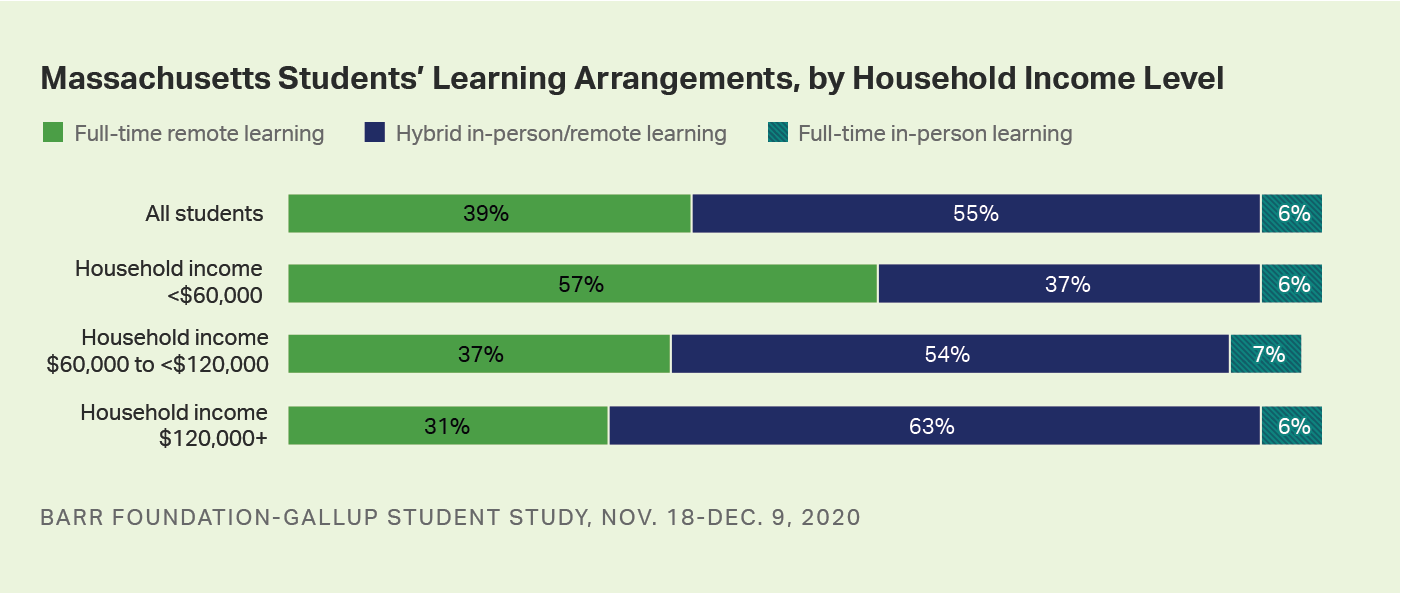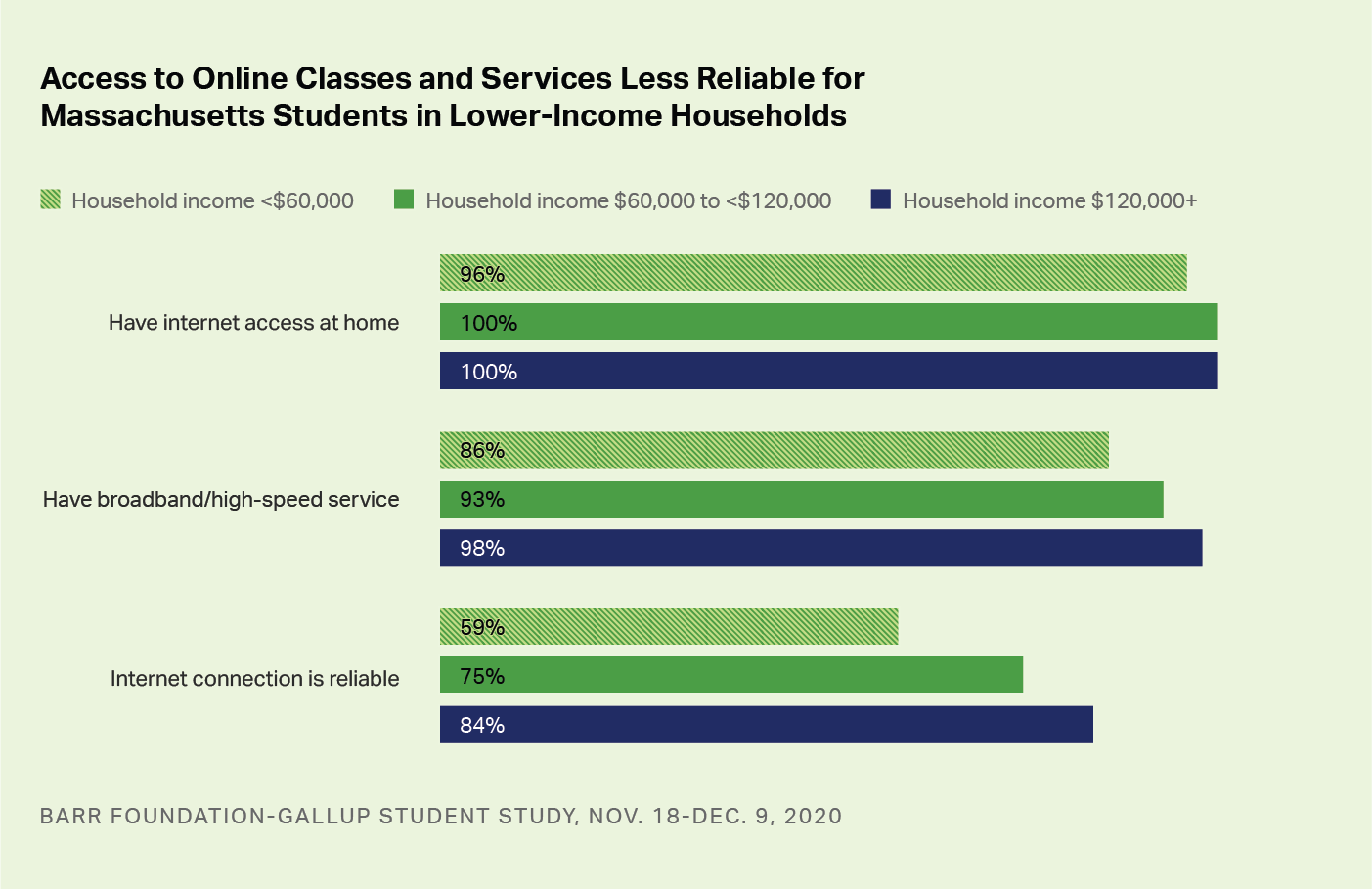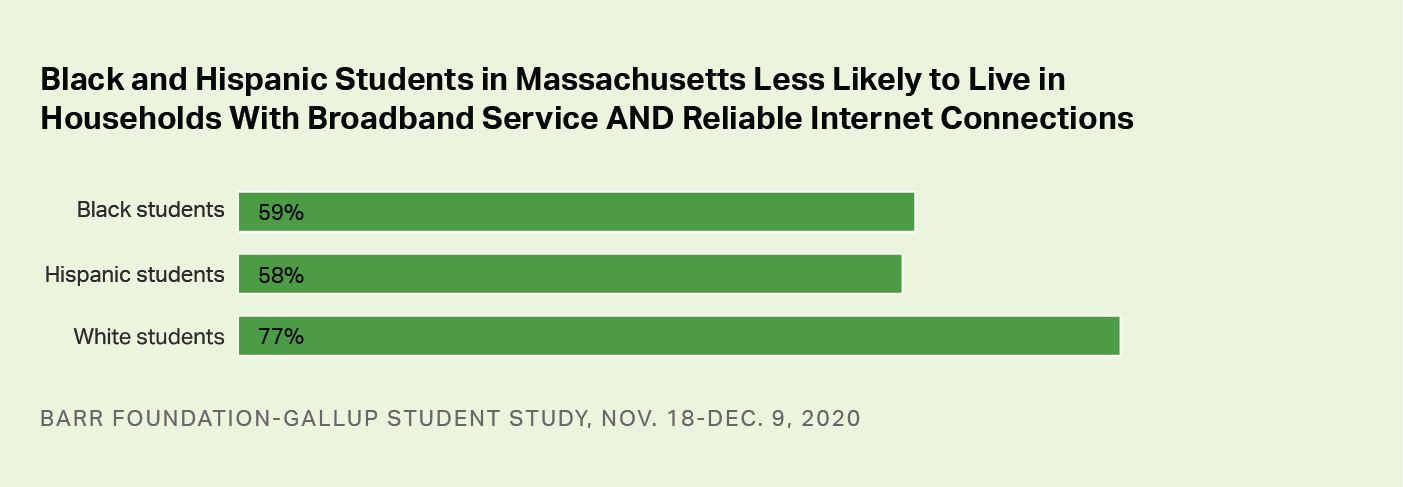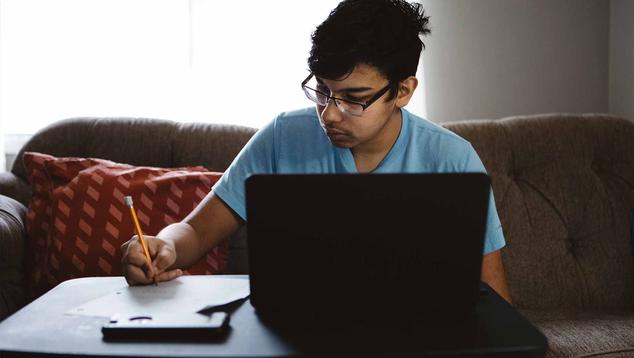Story Highlights
- 16% of Massachusetts students aged 14-18 prefer full-time remote learning
- Low-income students most likely to be learning remotely full-time
- Low-income students also less likely to have reliable high-speed internet
WASHINGTON, D.C. -- A new Barr Foundation and Gallup study of Massachusetts high school students finds that, while many are currently learning remotely full-time, relatively few -- 16% -- say this is their preference. Half of Massachusetts students (50%) say they prefer to learn in person full-time, while about a third (34%) say they prefer a hybrid in-person/remote arrangement.

Horizontal bar graph. Massachusetts students' current learning preferences (aged 14 to 18). 50% would prefer to attend school in person, full-time. 34% would prefer a hybrid in-person/remote arrangement and 16% would prefer to attend school remotely, full-time.
These findings are based on telephone surveys with 1,000 Massachusetts students, aged 14 to 18, conducted by Gallup for The Barr Foundation Nov. 18-Dec. 9, 2020. The study was conducted in English or Spanish, depending on respondent comfort level, and includes students in private, public district and charter schools.
Though attending school full-time in person is students' most common preference, only a small fraction have been able to do that this winter amid record-high coronavirus cases in Massachusetts, as in the U.S. nationwide. The study finds that overall, 39% of Massachusetts students are learning full-time from home, while 55% are in hybrid in-school/at-home learning arrangements and 6% are learning in person full-time. Students from lower-income households in the state are far more likely than those in middle- and upper-income households to be learning remotely full-time.

Horizontal bar graph. Massachusetts students' current learning arrangements, by household income (aged 14-18). Among households earning less than $60,000 per year, 57% are in full-time remote learning, 37% are in hybrid in-person/remote learning and 6% are enrolled in full-time in-person learning. For households earning between $60,000 and $119,999 per year, 37% are in full-time remote learning, 54% are in hybrid in-person/remote learning and 7% are enrolled in full-time in-person learning. In households with incomes of $120,000 or more per year, 31% are in full-time remote learning, 63% are in hybrid in-person/remote learning and 6% are enrolled in full-time in-person learning.
These findings come in the context of widespread concerns that the pandemic is exacerbating existing disparities in educational outcomes between disadvantaged students and others. Though recent analyses of testing data indicate that the transition to remote learning has resulted in significant learning loss among U.S. students, those losses are particularly severe among low-income and minority students.
Low-Income and Minority Students Less Likely to Have Online Access
Though they are more likely to be learning remotely full-time, low-income and minority students in Massachusetts are less likely to live in households with reliable high-speed internet connections, according to reports from their parents. Though almost all students in households making less than $60,000 have internet access at home, about one in seven (14%) do not have broadband service and about four in 10 (41%) do not have reliable connectivity.

Horizontal bar graph. Massachusetts' students' access to online classes and services, by their household income. 59% of households earning less than $60,000 a year have a reliable internet connection, compared with 75% of those with incomes between $60,000 and $119,999, while 84% of those with incomes of $120,000 or more say the same.
Differences by income group are also reflected in discrepancies between racial and ethnic groups. For example, 77% of White students in Massachusetts live in households with broadband internet connections that their parents describe as reliable. This figure falls to 59% for Black students and 58% for Hispanic students.

Horizontal bar graph. Massachusetts students' access to broadband service and reliable internet connections, by their race/ethnicity. 77% of White students have both broadband service and reliable internet, compared with 59% of Black students and 58% of Hispanic students.
Students' responses also reflect the challenges facing lower-income parents, who may have less experience with computing devices and online platforms than those from more affluent backgrounds. Overall, 85% of Massachusetts high school students say there is someone at home they can ask for help if they have trouble accessing schoolwork or using technology -- but that figure is 71% among those in households earning under $60,000 a year.

Horizontal bar graph. Massachusetts students with someone at home to help with technology, by household income. 71% of households earning less than $60,000 a year have someone at home to help students with technology issues, compared with 89% of those with incomes between $60,000 and $119,999 and 90% of those with incomes of $120,000 or more.
Implications
The coronavirus pandemic's disruption of K-12 education is likely to be one of its most enduring effects. A survey of Massachusetts parents conducted in October and November 2020 found significant gaps by income and racial group in access to in-person schooling, and parents of children in distance-learning situations were more likely to feel their child was falling behind grade level.
The Barr Foundation-Gallup student study further adds to educators' understanding of the transfer to distance learning by exploring students' preferences and their reported access to the resources they need to do well in a remote learning situation. Such perceptions are a crucial link that sheds light on the specific challenges educators are contending with as they help distance-learning students succeed through the pandemic.
To learn more about this study, read the full report.




